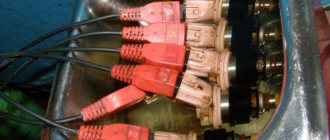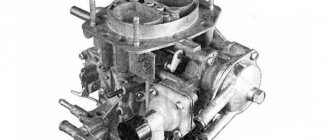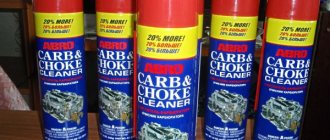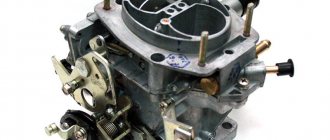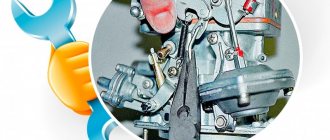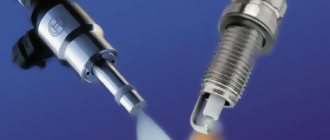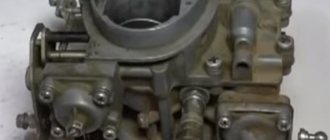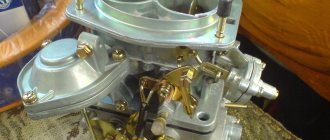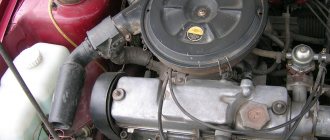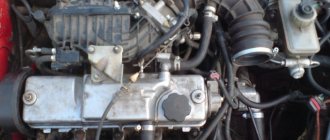As the requirements for the engine power supply system became more stringent, carburetors, as the most complex components on the way of gasoline and air to the cylinders, underwent serious modifications and went from simple fuel sprayers to serious multi-tasking pneumohydraulic devices.
In Russia, this path ended with the creation of Solex-type carburetors; nothing more advanced was produced in our country; the time has come for fuel injection systems.
How did the Solex carburetor come about?
The evolution of carburetors for VAZ cars began with the use of fairly efficient Weber-type devices and continued in the Ozone family, which were the same two-chamber Weber, but with additional measures to improve environmental friendliness.
Especially during start-up and warm-up, as well as overall fuel economy through the use of a slightly leaner working mixture, where exhaust toxicity was simultaneously reduced.
However, with the advent of the promising front-wheel drive VAZ-2108 family, the further use of ozone had to be abandoned. They could not work normally on a transverse engine, and their efficiency reserves were exhausted.
The new carburetors were based on devices from Solex, a well-known French manufacturer that supplies many world brands of cars and motorcycles with its products.
This is interesting: How to replace power steering fluid
Initially, Solex carburetors were used on 1.1 and 1.3 liter engines of VAZ 21081 and 2108 cars; with the advent of an engine with an increased displacement of up to 1.5 liters, model 21083, a similar device was developed, differing only in calibrations, but giving rise to a whole family of power supplies including cars with a classic layout, as well as all-wheel drive Niva with engines up to 1.7 liters. Similar modifications were used for Muscovites, as well as in the later Volga.
Flushing the carburetor without removing it from the engine and disassembling it
Let's look at the procedure for flushing the carburetor without dismantling it using Hi-Gear HG 3205. We need one can of this liquid (295 ml). In stores it costs about 300 rubles, and is designed for 40 liters of gasoline. One jar is enough for a one-time wash. The application procedure is as follows:
- We head to the nearest gas station.
- Unscrew the fuel tank cap.
- Open the can of washing liquid (it opens like a beer can).
- Using a watering can, pour the product into the tank.
- Fill the tank with gasoline (until full);
- We drive the car until the fuel runs out.
Solex 21083 carburetor design
A characteristic feature of the 21083 carburetor, associated with its purpose for a transverse engine arrangement, is a two-section chamber with two floats, which makes it possible to stabilize the mixture composition during acceleration, braking and sharp turns with variable acceleration.
Float chamber
Both floats are connected to each other by a common bracket, which presses upon the spring-loaded ball valve for supplying gasoline from the fuel pump during ascent. In this way, the fuel level, which is the base value for many settings, is kept constant. Small fluctuations do not greatly affect operation and are taken into account during calibrations.
The above-float space is balanced, that is, pressure is maintained in it after the air filter, so that its transition resistance does not affect the settings.
Idle system
Idle speed is provided in a less complex way than in Ozone; there is no completely autonomous system. Gasoline comes from the emulsion channel of the main metering system of the first chamber, after which it is mixed with air from the idle air jet, and the resulting mixture is sucked through the hole under the throttle of the first chamber.
The system also contains an electric forced idle valve that shuts off fuel during engine braking and a variable cross-section port in the wall near the edge of the throttle valve.
Main dosing system
Consists of two main fuel jets, two air and emulsion tubes, one set for each chamber. The mixture is formed in small diffusers installed inside the air flow through the large diffusers of the first and second chambers.
The flows are connected sequentially as the load increases, by alternately opening both throttle valves.
The qualitative composition of the mixture is determined by the ratio of the jet cross-sections and the fuel level in the float chamber. The quantity corresponds to the flow rate and vacuum in the diffusers.
Acceleration pump
To enrich the mixture at the moment of sharp opening of the throttles, due to inertial effects, it is necessary to use an additional accelerating pump. This is a diaphragm, driven through a rod from a cam on the throttle drive, injecting gasoline through nozzles into both chambers.
When the second chamber is still closed, in order to avoid the accumulation of gasoline from the accelerator there, the throttle is installed with a small gap relative to the walls, through which additional gasoline escapes.
Economizer
When the load is sufficiently large, the throttle of the first chamber opens completely, the vacuum under it drops, and this change in pressure is used to further enrich the mixture.
This is done by the spring-loaded diaphragm of the power mode economizer, opening an additional channel for fuel supply to the nozzle of the first chamber. At low loads, the vacuum moves the diaphragm away from the ball valve and prevents the mixture from being enriched.
Econostat
The simplest carburetor system, operating under heavy loads, full opening of both dampers and maximum crankshaft speeds.
It consists of a sprayer and a single fuel nozzle that takes gasoline from the float chamber. It begins to suck in additional fuel with a large air flow, creating the necessary vacuum in the sprayer area.
Manual damper regulator (choke)
When starting a cold engine, the mixture must be enriched, so the carburetor is equipped with a manually operated air damper via a cable from the cabin. When the suction is pulled, the air in the first chamber is blocked, and the throttle is slightly open, which ensures the required composition.
After the first flashes, the vacuum increases, opening the air damper through the diaphragm to prevent excessive enrichment and flooding of the spark plugs.
All mechanisms can be adjusted to ensure optimal starting. On some modifications, manual drive is eliminated with the installation of an automatic starting system, activated by fully pressing the accelerator pedal.
Aerosols
It is convenient to work with them, since the aerosol comes out under pressure and additionally clears blockages with a flow of air with the mixture. Sprayers contain propane, acetone and a number of other dangerous components. Therefore, avoid getting them in your eyes and hands. How to check the oxygen sensor on a VAZ 2114 is frozen. They catch fire easily and can only be extinguished with carbon dioxide fire extinguishers.
Aerosol Abro for carburetor cleaning
Aerosols do an excellent job, but they cannot clean the float chamber.
The cleaning process is the same for all cars:
- Remove the air filter;
- Spray cleaner through the tubes outside and inside;
- After 3 minutes, start the engine at high speed and spray the product intermittently for 2 minutes.
This process will take you a maximum of 15 minutes.
How to remove a Solex carburetor
To remove the carburetor from the car for the purpose of repair, maintenance or replacement, it is necessary to disconnect the mechanical, pneumatic, electrical and fuel fittings from it, and then unscrew the nuts securing it to the manifold flange:
- Remove the air filter housing by unscrewing the center cover nut and the four flange nuts on the carburetor top studs.
- Disconnect the electrical connectors of the limit switch and solenoid valve.
- Remove the return spring and disconnect the throttle cable.
- Disconnect the choke actuator.
- Loosen the clamps and remove the fuel supply and return hoses.
- Disconnect the hoses of the distributor vacuum regulator, crankcase ventilation and throttle heating unit.
- After unscrewing the four nuts of the intake manifold studs, remove the carburetor.
When reinstalling, special attention must be paid to the tightening of these nuts, since the lower plate of the housing is very easily deformed from excessive force, after which air begins to leak into the manifold.
Adjustment, adjustment and cleaning
It is very undesirable to make changes to the calibration of the Solex carburetor, since this is a very accurate and balanced device with well-chosen characteristics.
All adjustments are of an operational nature and rarely change, but they must be checked preventively and adjusted if necessary:
- Adjusting the composition of the idle mixture is carried out using a gas analyzer, since the carburetor has great capabilities for ensuring minimal CO and CH emissions; it comes down to setting the permissible level of harmful gases with the “quality” screw at the nominal idle speed.
- The starting device is adjusted by changing the position of the cable sheath on the bracket so that the damper is fully open and closed in the extreme positions of the choke button.
- The fuel level in the float chamber is set so that when the top part of the carburetor is inverted and installed horizontally, the gap between the floats and the gasket is approximately 2 mm. After which the level can be checked by attaching the cap, starting the engine, turning off and removing the cap, the distance from the gasoline to the flange should be approximately 24 mm.
More subtle settings are available only to a qualified specialist, since changing some of them leads to disruption of others, so you can quickly bring the device to an inoperative state.
The same can be said about cleaning the carburetor. The use of a rough metal tool will lead to changes in the cross-sections of channels and jets. It is only allowed to wash the parts and channels of the housing with special aerosol carburetor cleaners after complete disassembly.
Expert advice
Clean carburetor
Since you decide to do the cleaning yourself, then pay attention to a few tips from professionals.
- Buy carburetor cleaners at automotive chemical stores. Some sellers will try to sell you a different, "better" product that is not designed for carburetors. Refuse, since it is unknown how such a drug will react to dirt inside the carburetor.
- The well-known, world-famous product WD40 is not suitable for cleaning the carburetor. The reason is simple - it contains oil.
- You will need carburetor cleaner in a bottle. Finding him is not a problem.
- Don't think that simply spraying carburetor spray will fix the problem. VAZ (Lada), carburetor for Niva 2121 carburetor and which carburetor to put on. How to easily clean a burner on a gas stove - youtube. This is wrong. There may be an effect, but it will be temporary.
- If it is heavily soiled, there is nothing left to do except remove, disassemble and wash the carburetor.
- You can contact a service station. But only if you are confident in the professionalism of the people or you have friends who work there. They charge a lot of money for the work, but not everything is washed as efficiently as they would do it for themselves. Plus, it is unknown what means they use. It is not uncommon for special expensive cleaners to be replaced with cheap gasoline or simple solvents.
Major Solex faults
Almost all malfunctions are associated with aging of parts and clogging of channels with poorly filtered or low-quality gasoline, as well as airborne debris passing through a defective air filter:
- fuel overflowing through a faulty float chamber valve, the engine starts poorly when hot, black smoke comes from the muffler;
- contamination of the jets of the main dosing system, the engine loses traction, starts poorly, shoots into the muffler or air filter;
- the tightness of the diaphragms of the starting system, accelerator pump or economizer is lost;
- general contamination of the carburetor when using low-quality fuel or getting water into it, power is lost, starting is difficult;
- the throttle valves are worn out, it is impossible to adjust the idle speed, failures in transient modes;
- non-flatness of the lower flange due to overtightening of the nuts, air leaks, loss of idle speed and power;
- clogging of the accelerator pump, failures during acceleration;
- The transition system of the second chamber is clogged, failures at medium acceleration modes.
Often the carburetor is blamed for problems created by the ignition system or gas distribution mechanics of the engine. Therefore, this technically complex device should be dealt with last, after making sure that all other systems are in full working order.
Express cleaning methods
The process of blowing and cleaning the parts of a Solex carburetor with your own hands is a long and labor-intensive task, so the question of how to clean a VAZ 2109 carburetor without removing it is relevant for most owners of nines.
For quick washing without dismantling, various auto chemicals are used - the so-called “liquid cleaning”. Sold in cans of 300-500 ml. Some products are designed to be poured into a tank. You need to fill the product with a small amount of gasoline remaining and drive until the fuel runs out. Repeat the procedure after 5-7 thousand km. After first use, clean the gas tank as a preventative measure.
Another group of products is intended for “local” use. The air filter is dismantled and the aerosol from the can is pumped directly through the tubes of the device. After this, you need to start the engine and let the car idle. These products are not a panacea for a heavily contaminated carburetor, but only help in the aspect of prevention and removal of minor contaminants. Even with regular use of this auto chemical, cleaning the carburetor of the VAZ 2109 should be carried out at least three times a year.
